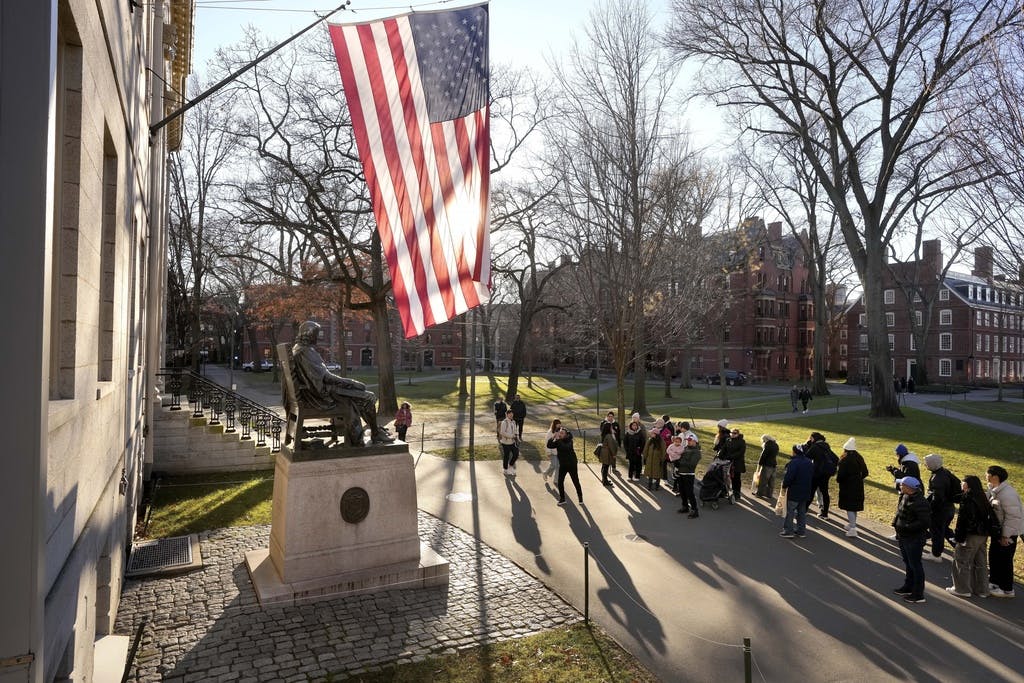As DOGE Targets Higher Education, Universities Might Save Themselves by Cutting Costs on Their Own
Harvard students develop on X a ‘DogeU’ account that posts about university grants they say should be cut.

President Trump wants Elon Musk to use a “scalpel,” while Musk prefers a chainsaw, against colleges and universities.
The National Institutes of Health is seeking to slash the rate it pays in indirect cost reimbursements for university research in the name of cutting the “Liberal D.E.I. Deans’ slush fund,” in an effort to save taxpayers $4 billion per year.
President Trump is threatening to pull all federal funding from schools like Columbia that allow what he calls “illegal protests.” The fundamental finances of many higher education institutions could be upended.
Could American universities save themselves by forming their own kind of internal “DOGE”?
Though legal challenges have paused some of Mr. Trump’s cost-cutting measures, institutions are already bracing for impact by freezing hiring and cutting back on the number of PhD students they will accept. Yet some say that the current moment presents an opportunity for schools to take aim at expanding administrations, slim down their ballooning budgets, and perhaps cut down the costs of going to college.
The growth of university bureaucracies in recent years is undermining the ultimate mission of higher education, says author Benjamin Ginsberg of the 2014 book, “The Fall of the Faculty: The Rise of the All-Administrative University and Why It Matters.”
“To most professors, the purpose of the university is teaching and research,” Mr. Ginsberg, who chairs a political science center at Johns Hopkins University, tells the Sun. “To the bureaucrats, the purpose of teaching and research is to bring customers to the university.” His research finds that if university administrations were roughly the same size as they were in the 1960s, tuition could be cut by about 40 percent.
Yet it appears the bureaucrats are increasingly running the show. A 2021 survey of 65 large universities found that the average school has more than 45 people devoted to diversity, equity and inclusion, making it “the fastest-growing segment of the educational bureaucracy, with, say, staffs on average four times larger than those providing legally mandated accommodations to disabled students,” writes Ilya Shapiro, author of the recently released book, “Lawless The Miseducation of America’s Elites.”
DEI professionals encompass only a sliver of college administrations. Researchers have found that between 1976 and 2018, the number of full-time administrators and other professionals employed at colleges and universities in America increased by 164 percent and 452 percent, while the number of full-time faculty employed at colleges and universities in the U.S. increased by just 92 percent. At some universities, including the California Institute of Technology, Duke University, and the University of California at San Diego, there are more non-faculty employees on campus than students.
“Routine administrative work of all sorts that used to be undertaken by a president, a provost, a dean, has now metastasized,” Mr. Ginsberg says, “so that there is an army of vice provosts, associate provosts, and assistant provosts, each of whom has assistants working for them. Do they really do more than the provost used to do?”
Schools have also expanded their offices for student services, in part due to changing student demographics and demands. Today’s campuses include more students who are first-generation and low-income. Mental health challenges have also been on the rise. Expanded college-sports participation demands more athletic staff, and increased federal regulations require new departments, such as disability offices and investigation teams for sexual-assault complaints.
Advocates say that these investments are critical to help students succeed in college. Yet Pomona College economist Gary N. Smith has argued that the expansion of college administrations is fueled by the phenomenon of “empire building.” Power is pulled from instructors and researchers and toward university administrators, who seek to increase their status by hiring more persons beneath them, who will, in a self-fulling cycle, want to hire more people beneath them.
Support staff “no longer mainly exist to support the faculty,” one author, David Graeber, of the 2018 book Bullshit Jobs: A Theory, has argued. Rather, professors now must spend “more and more time measuring, assessing, discussing, and quantifying the way in which they study, teach, and write about things.”
While administrative positions are on the rise, the ranks of tenured faculty are flat or declining. Hiring a new professor typically takes one and a half academic years, a process involving the formation of a search committee, extensive interviews, and decision-making. Hiring an administrator, by comparison, typically takes on average two to three months at Harvard. Meanwhile, many non-tenured teaching positions are subject to term limits, or “time caps,” a policy that 91 percent of students and faculty surveyed at Harvard support lifting.
“One thing that Harvard should do is just make it really easy to hire the best professors,” a junior at Harvard and the president of the Harvard Republican Club, Leo Koerner, tells the Sun. “The best people at Harvard that are supporting students,” he says, “are the professors.” He argues that granting them more power over their own departments, and streamlining the process of hiring new ones, would return the university to its central mission of excellence.
Currently, administrators seem to be wielding more authority, including intervening in students’ management of independent clubs on campus. “If you run a club in any sort of capacity, you have to go through these mentored full-day training every year where they tell you how you can do this or can’t do that,” Mr. Koerner says, adding that any student undergoing such training would resent the administration.
Harvard students have even developed a “DogeU” account on X that posts about university grants they say should be cut. On the chopping block, they argue, is Harvard’s $100 million “Legacy of Slavery Fund,” which operates a “Reparative Partnership Grant Program” that would cover budgets up to $350,000 for projects that “address systemic inequities affecting local descendant communities.”
“The university could do a sort of internal government efficiency department,” Mr. Koerner says. “If they had proper messaging, I think everyone would support it — except perhaps those who are perpetuating it.”
If schools aren’t forced to cut their budgets at the direction of the Trump administration, they might soon be compelled to streamline and slim down their operations amid diminishing enrollment. The undergraduate headcount in America is set to decline by more than 575,000 students between 2025 to 2029. That represents a 15 percent drop that could cause many schools to close shop lest they streamline their operations.
Whether it’s this looming “enrollment cliff” or the chainsaw coming from Washington, “bureaucracies can only be shaken by earthquakes,” Mr. Ginsberg says. “The only way you can change a bureaucracy is to really uproot it.”

